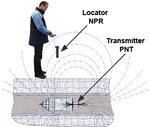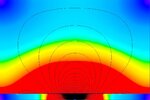Mohammad_Pirzadi
Advanced Member level 4
- Joined
- Nov 15, 2016
- Messages
- 100
- Helped
- 0
- Reputation
- 0
- Reaction score
- 0
- Trophy points
- 16
- Location
- Khorramabad, Iran
- Activity points
- 829
hi dear users. please reply to my comment #99. I am waiting.
Follow along with the video below to see how to install our site as a web app on your home screen.
Note: This feature may not be available in some browsers.
hi dear users. please reply to my comment #99. I am waiting.
thanks to all for their valuable feedbacks. the proposed approaches by you dears pushed me into a meandering labyrinth and now I am completely baffled, because no schematic has presented for a better decision. but the most important note that I have noticed is that utilizing resonance inductive coupling method is almost useless due to absorption by a steel pipe. consider the following text:
1- please aware me if you think using the resonance inductive coupling is still a useful method.
2- since I have no previous experience in design of transceiver systems, plz help me step by step (accept my apologizes).
3-firstly I picked 22Hz frequency because some commercial PIG locator systems use that for passing steel pipe and soil. but which frequency is the best?
4-what is the best method for realizing this nightmare project?
best regards
Mohammad
please use words correctly! no one was demanded. it's only a help request. in here big men like Mr Brian, FvM,Betwixt and some others (now I cannot remember all) helped me and I owe to them forever. their valuable feedbacks will not be appreciated by words.you have already been told once DONT be impatient and STOP making demands
doing that is really going to stop people helping you ... no one likes being demanded to do things, specially for those that wont help themselves
1) possibly ... is that the way commercial systems do it ?
2) no one has the time or ability over the internet to help you step by step .... you need to find people close to you that can work directly with you in a well equipped workshop
3) well if commercial systems use that freq, then there will be a reason for that ..... probably cuz it's the best choice
4) buy a commercial system, as you apparently don't have the electronics knowledge to build one
Sorry to be blunt, but it's time you need to understand these things
regards
Dave
Ground penetrating radar generally only has a range of about 1.5 metres but the transmitting and receiving equipment are on the surface. That implies a range of 3m may be possible in a straight line. However, it will find but not penetrate solid objects, particularly metalic ones so even if it could trace the pipe location, it wouldn't find where the Pig was inside it.
A low power magnetic field generator at 22Hz would be difficult to pick up from 4m away in free air. Partially shielding it in soil will reduce the received strength and encasing it in metal pipe will virtually stop it completely, the combination of the two makes the concept of location just about impossible. As far as I can tell, the commercially available units have very short range, only a few cm and are usually clamped to the pipe or at least encircle it, making induced currents easier to detect.
The simple truth Dr Mohammad, is that none of us have any experience in this highly speciallized field so anything we suggest is based on theory and not on experience. We are doing our best to solve a difficult problem for you by suggesting alternatives you could try out but unless you can experiment to assess their feasibility, we can't tell which options are best to pursue.
So far we have suggested:
1. ways of inducing EM fields around the pipe
2. ways of inducing current into the pipe
3. permanent magnetic field sources
4. types of antenna and receiver with narrow beamwidth and high sensitivity
5. acoustic methods using mechanical generators
6. acoustic methods using electronic generators
7. acoustic triangulation
8. acoustic time domain reflectometry using 'ping' and multi-tone methods
Have you tried any of these methods and can you report back your results?
Brian.
You have to decide on transmitter frequency but I'm not convinced any particular frequency would be better than another.do you have any idea or circuit for realizing 3Hz to 30 KHz transceiver
You have to decide on transmitter frequency but I'm not convinced any particular frequency would be better than another.
For the receiver, you need the pick up coil (antenna) and a laptop with a microphone input. There are many audio analysis and spectrograph programs you can use. When a frequency, 22Hz or another, is decided upon, you can design narrow band filters to eliminate unwanted signals and then replace the laptop with a signal strength meter.
Brian.
I believe the transmitter design is straightforward, too. I sketched my ideas in post #51 two weeks ago.design of receiver is almost straightforward. the major&critical problem is designing of extreme low frequency transmitter!



I believe the transmitter design is straightforward, too. I sketched my ideas in post #51 two weeks ago.
I also made a simple axisymmetric simulation setup to get an idea of the expectable field strengths and dependency on transmitter geometry, tube wall thickness and frequency. The transmitter orientation follows the previously manufacturer quoted literature.
One result is that you need very wide simulation boundaries (e.g. several 10 m) for a quantitative results because the field is "conducted" along the tube. I wasn't able to implement ferromagnetic losses in the simulation, only eddy currents, thus I'm not sure if the tube field decays faster in reality. Due to tool restrictions, I'm, modeling the 0.5 m tube in a limited z=+/- 3m, r=4m volume. Wall thickness is 15 mm, µr=1000, conductivity 1.6e6 S/m.
The transmitter uses a 20 x 150 mm ferrite rod with a 100 mm cylindrical coil around it. With 1000 AW excitation at 22 Hz, I get about 10 nT flux 2m above the tube center. Due to the previously mentioned model limitations, this should be seen as an order of magnitude rather than an exact prediction.
Although I used a high µr power ferrite for the core, the simulation shows that lower µr values down to 500 or even 250 (usual antenna ferrite rods) reduce the field strength not more than 10 or 20 percent.
View attachment 134186
Basic pig localization setup according to www.pigging.tools
View attachment 134187
Field outside tube
View attachment 134188
Field inside tube
Don't see how. Presuming linear behavior, which can be safely expected far below steel saturation field strength, both absorbed and transmitted signal is proportional to originally generated field strength. Increasing the generator field strength increases received signal.Absorption is proportional to the primary intensity of the magnetic field; if you increase the effective magnetic field, they will be absorpbed proportionately more. Weaker radiation has a better chance of getting out.
Don't see how. Presuming linear behavior, which can be safely expected far below steel saturation field strength, both absorbed and transmitted signal is proportional to originally generated field strength. Increasing the generator field strength increases received signal.
I already stated that a few meters of soil with a usual range of electrical conductivity passes low frequency magnetic fields without noticeable attenuation.
Attenuation by a steel pipe is the relevant effect, it's caused by
- the ferromagnetic material acting as magnetic short
- eddy currents generated in the conductor
The 10 - 30 Hz range has obviously shown to be best suited for VLF pig detection. You'll see that reducing the frequency gives better penetration of the steel tube, on the other hand induced voltage in a receiver coil is frequency proportional and amplifier noise is increasing at lower frequencies,
This idea is a possibility, not a certainty. Suppose you were to put a radioactive sample on board the pig, and detect it with a scintillation counter (extremely sensitive cousin of a geiger counter)?
I emphasize sample because my geiger counter has a radioactive sample taped to it, for testing purposes. (It isn't dangerous although you wouldn't want to store it under your bed.) Some types of smoke detectors contain a speck of Americium which is radioactive. Or a small rock of uranium ore (pitchblende) might be sufficient to place onboard the pig.
Scintillators are sensitive enough that they are used to detect radiation from a distance (example, cargo containers). Since lead shielding is needed to protect us from intense rays of this type of radioactivity, then perhaps it goes through steel? I have not used a scintillator so I can't be sure how well such a setup would work for you.
thanks, but due to health problems, the radioactive method is not proposed.